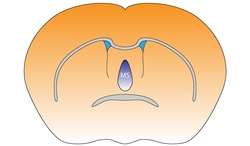Medial septal nucleus
The medial septal nucleus (MS) is one of the septal nuclei. Neurons in this nucleus give rise to the bulk of efferents from the septal nuclei. A major projection from the medial septal nucleus terminates in the hippocampal formation.[1]
| Medial septal nucleus | |
|---|---|
 Medial septal nucleus of the mouse brain | |
| Details | |
| Identifiers | |
| Latin | nucleus septalis medialis |
| NeuroNames | 262 |
| NeuroLex ID | birnlex_1668 |
| TA | A14.1.09.269 A14.1.09.446 |
| FMA | 61879 |
| Anatomical terms of neuroanatomy | |
It plays a role in the generation of theta waves in the hippocampus.[2] Specifically, the GABAergic cells of the medial septum that act as theta pacemakers target dentate gyrus, CA3, and CA1 interneurons. Pacemaking MS interneurons express hyperpolarization-activated cyclic nucleotide-gated (HCN) channels which are likely to promote their pacemaker properties.[3]
References
- Brodal, A (1981). Neurological Anatomy. New York, N.Y.: Oxford University Press. Retrieved 18 Jun 2011.
- O'Keefe, John; Andersen, Per; Morris, Richard; David Amaral; Tim Bliss (2007). The hippocampus book. Oxford [Oxfordshire]: Oxford University Press. p. 480. ISBN 978-0-19-510027-3.
- Colgin, Laura Lee (April 2016). "Rhythms of the hippocampal network". Nature Reviews. Neuroscience. 17 (4): 239–249. doi:10.1038/nrn.2016.21. ISSN 1471-003X. PMC 4890574. PMID 26961163.
This article is issued from Wikipedia. The text is licensed under Creative Commons - Attribution - Sharealike. Additional terms may apply for the media files.